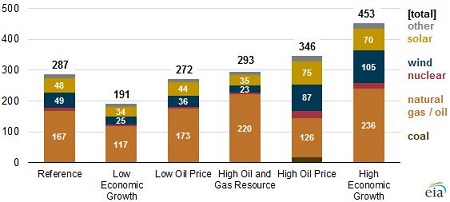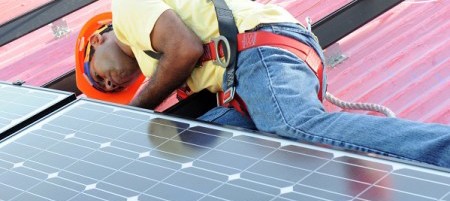SPECIAL REPORT:
In an “Annual Energy Outlook 2015” report, the US Energy Information Administration (EIA) provided a prediction which reflects current laws and policies.
In it, the EIA predicts that the total generating capacity (including end-use generators like rooftop solar panels) will increase from 1,065 gigawatts (GW) in 2013 to 1,261 GW in 2040.
This prediction adds that the amount of capacity added is more than three times the amount that is expected to retire, with 287 GW added and 90 GW retired.
 EIA’s forecast for solar energy capacity additions 2014–2040 range from 34 GW (low economic growth) to 70 GW (high economic growth). Source: U.S. Energy Information Administration, Annual Energy Outlook 2015. Vertical axis in Gigawatts
EIA’s forecast for solar energy capacity additions 2014–2040 range from 34 GW (low economic growth) to 70 GW (high economic growth). Source: U.S. Energy Information Administration, Annual Energy Outlook 2015. Vertical axis in Gigawatts
EIA predicts that about 17 GW per year of wind and solar projects will be installed through 2017, aided by federal tax incentives and renewable portfolio standards.
But from 2018 to 2024, projected capacity additions will average less than 4 GW per year, because earlier planned additions will be sufficient to meet most growth in electricity demand.
Going forward from 2025 to 2040, average annual capacity additions — primarily natural gas-fired and renewable technologies — will average 12 GW per year. By comparison, annual additions from 2000 to 2013 averaged 26 GW per year.
The 109 GW of renewable capacity additions in the Reference case are primarily wind (49 GW) and solar (48 GW) technologies, including 31 GW of solar photovoltaic installations from rooftop and other distributed generation installations.










Comments